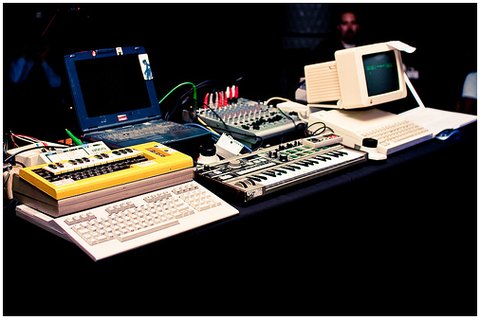Running a daily website is something of a controlled experiment in the passions of an enthusiastic community. 2009 was a year in which musicians pulled no punches in debating the merits not only of tools themselves, but of the ideas behind them. What follows is not the “best” of 2009, but the “biggest” – the stories that inflamed passions and got readers clicking and commenting. Some top lists include the items about which everyone agrees. This is the list of what got everyone arguing.
Software of the year: Propellerhead Record
For all the major releases and upgrades and gear, as well as the dominance of a certain Berlin-based developer, if you had to pick one application of 2009, it’d be Record. Record tops the list not because everyone dropped everything to go use it, but quite the contrary. Record bucked industry trends, and provided a love-it-or-hate-it view of what audio software could be. In other words, it was quite reminiscent of Reason.
Centered on a mixer, emphasizing “recording” (perish the thought), and omitting expected features like MIDI out and plug-in support, Record resists modern-day conventional wisdom. That was divisive enough, even before the debates began over Record’s new hardware key. In the long run, it may be the simple fact that Record brings audio signal to Reason that gives it staying power. But in 2009, Record was the application about which everyone had an opinion.
See our original preview, May, plus details on the "Ignition Key" authorization system
Developer of the year: Ableton
What a year it’s been for Ableton. The company kicked off the year with “Share,” “Extend,” and “Touch,” as well as the release of Live 8. It sounded simple. But Ableton’s tech dominated CDM headlines in ‘09 with the variety of user tips and tricks, rants and raves. How’d they do?
New gear: Hardware was in the spotlight – and ranked highest in CDM clicks – even above the software. Many users embraced Akai’s APC40, the first commercial hardware to really balance a variety of Live’s features, as well as Novation’s affordable, simple Launchpad grid controller. But even as Ableton emphasized the ability of this hardware to work out of the box, hackers set about customizing their own control. We saw the Launchpad used with Renoise (complete with a mocked-up Renoise logo decal), and the Korg nanoKONTROL hacked to integrate more seamlessly with Ableton – even when KORG and Ableton themselves hadn’t worked on support. Lesson learned? Make tools for musicians, and you may find some support and development gets crowd-sourced, whether you intended it or not.
See: Hands-on with the Launchpad, nanoKONTROL Myr for Ableton Live, APC40 Hacking Superguide
Live, meet Max: Max for Live has already led to some incredible work, most notably stretta’s fantastic compositional toolkit for the monome. It earned praise (for setting a new bar for sheer power) and criticism (most notably for lacking a free runtime). Some jumped on M4L, some swore they’d stick to the traditional Max, and others swore they’d seek alternative or free solutions. In the end, Max for Live has wound up becoming bigger than, well, Max for Live. It’s begun a discussion of how live performance should work, and how software should integrate and be extended. And that’s a story that should be with us for a long time.
And a few wrinkles: The third prong of Ableton’s initiative was barely visible in ‘09; while a beta is underway, we don’t know much more about how Share will work in December than we did at NAMM in January. Live 8 has been beloved by some, even as others users expressed frustration with stability issues. CEO Gerhard Behles surprised everyone this month on the Ableton forum by conceding the company could do better and promising developers would re-focus on squashing bugs, even putting new features on hold.
As the saying goes, any press is good press. Ableton and their fired-up user base stayed front-and-center on CDM in 2009, even as twists and turns complicated the narrative. The story isn’t quite as clean and tidy as it is was at the beginning of the year, and you can read the full spectrum of comments calling this year everything from a triumph to a failure (and, hopefully, a few more reasonable thoughts in between). But without a doubt, Ableton is the developer of 2009.
Story of the year: Switching from Mac to Ubuntu
After years of tired debates about the merits of operating systems, the potential of the philosophies of open source versus proprietary, and whether Linux is ready for the desktop, in 2009 we saw a new spin: what if you switched to Linux to make your life easier?
That was the question Kim Cascone asked with his switch to Linux. And he wasn’t alone. One of the most-asked questions this year was how to make Linux work for music, particularly as users sought out more-reliable, more-affordable solutions for audio. (Yes, I know – “Linux” isn’t necessarily more reliable out of the box, as “Linux” could mean any number of setups, which I suspect is part of why the question was asked so much.) The popularity of Kim’s story, along with the turnkey Indamixx laptop or the Linux Laptop Orchestra we saw last week, suggest a challenge to CDM as much as a story. It’s the story we’ll likely see more of in 2010.
Linux Music Workflow: Switching from Mac OS X to Ubuntu with Kim Cascone
Biggest opportunity: Rock Band Network
Want a glimpse into the future of the music business? Here’s one way it could look. Rock Band Network provides an extraordinary level of control and customization, allowing your music to work as well with the hit game as music adapted by the developers themselves. As a revenue stream, as a promotional opportunity, and as a new way to play with your music, it looks fantastic. And don’t miss the fact that what made it possible was close collaboration with the DAW Reaper – a big coup for that package. Now, if we could just have the Amplitude Network, too, for electronic artists.
See our inside look at RBN with the folks at Harmonix
Surprise vintage tech: The return of CV
MIDI? What’s that? The biggest surprise revelation in January was that MOTU was set to release a brilliant plug-in called Volta, which elegantly bridged the gap between computers and, through control voltage, analog synthesis. Matthew Davidson (who wowed us with OSC and digital tech in 2009, too, in his monome work) walked us through his creation:
Analog, Meet Digital: MOTU Volta Connects the Mac to CV Synths, Effects Graphically
We also saw other CV solutions, DIY and commercial, Control Voltage on Moog’s Theremin, and in perhaps the hardware product of the year, Moog Music’s exquisite double-band MuRF resonant filter. And yes, the Moog piece even has MIDI for pattern changes and sync, while still making use of CV.
Most annoying story of the year: Anything to do with T-Pain
Yes, the iPhone is well awesome mobile technology. Yes, 2009 was the year in which the music world went from talking exclusively about “albums” to talking about “apps,” too. Yes, it’s amazing how Smule has popularized music technology and alternative interfaces and all that good stuff. Unfortunately, it was tough to focus on some of the wonderful things going on when you had to deal with the sudden and inexplicable success of T-Pain, capitalizing on everyone’s least-favorite effect – AutoTune. Not getting enough overuse of pitch correction on FOX’s hit show, Glee, ruining talented voices of kids and Broadway stars? Now put it on your iPhone, and suck the joy out of the (otherwise fantastic) “I’m on a Boat” video. We all love you, Smule, but, I’m on a phone? I’m in a time machine, trying to escape to some year where AutoTune has finally died.
To cheer up, let’s just remind ourselves why Smule’s chief mind Ge Wang is still cool, while I try to work out how to get off T-Pain’s press mailing list:
Interview: Smule’s Ge Wang on iPhone Apps, Ocarinas, and Democratizing Music Tech
And the Rest
Most important OS release:
Windows 7, for finally making us feel good about leaving XP – and, with the help of tools like Cakewalk’s SONAR and its BitBridge 32-bit plug-in support, giving us a good reason to go 64-bit, too.
Most popular how-to’s:
Instructable: How to Build a Music Studio in an Apartment
Abusing and misusing groove extraction in Live 8
Best reason to attend NAMM 2010:
The hopes of catching Teenage Engineering’s OP-1 synth, in the flesh

Most popular feature, and a reminder of what matters more than the gear:
Take it to the Stage: Reflections on Live Laptop Music from Artists
This analysis piece from a variety of top artists started a discussion about what playing laptops is all about. There was certainly no consensus, but it was – rightfully – the most popular feature story of the year, and something we should cover as often as possible. It’s the reason we’re all here. (Thanks to Primus Luta for putting this together.)
More Top 2009 Lists
Beatportal
Francis Preve takes on the top ten releases of the year for Beatportal, and I can’t help but agree. Having made my list of what caused the most controversy, these are the tools that – big splash or not – deserve some technological recognition.
MetaSynth remains a fascinating and unique tool for sound design, finally in a more modern release, and one I hope to work with more soon.
Logic 9 was a huge DAW release, though to that list I’d add SONAR 8.5 – two radically different tools, each markedly more mature this year.
FXpansion DCAM Synth Squad looks like the most brilliant soft synth of ‘09, and I’m long overdue in spending some quality time with it.
Dave Smith’s Tetr4 synth might make the top of my list if it didn’t have to compete with other fine synths from … Dave Smith.
Then there’s Melodyne, which resulted in some unique and creative results this year.
A must-read: 2009 Studio Technology Top 10
MusicRadar
MusicRadar, the online site that accompanies Computer Music and Future Music (among others), reviews the year month by month. But the list you want is:
In pictures: the best hi-tech gear of 2009
Yours’
Of course, in the end, what all these stories have been about is the full spectrum of ideas from our readers. So have at it. And Happy New Year.
![recordmixingconsole-thumb[1] recordmixingconsole-thumb[1]](https://cdm.link/files/2009/12/recordmixingconsolethumb1_thumb.png)
![3951514441_6215fafcfa[1] 3951514441_6215fafcfa[1]](https://cdm.link/files/2009/12/3951514441_6215fafcfa1.jpg)
![stretta1_t_thumb[1] stretta1_t_thumb[1]](https://cdm.link/files/2009/12/stretta1_t_thumb1_thumb.jpg)
![baudlinedesk_t[1] baudlinedesk_t[1]](https://cdm.link/files/2009/12/baudlinedesk_t1_thumb.jpg)
![reaperrockband_t_thumb[1] reaperrockband_t_thumb[1]](https://cdm.link/files/2009/12/reaperrockband_t_thumb1_thumb.jpg)
![voltaplusmodular[1] voltaplusmodular[1]](https://cdm.link/files/2009/12/voltaplusmodular1_thumb.jpg)
